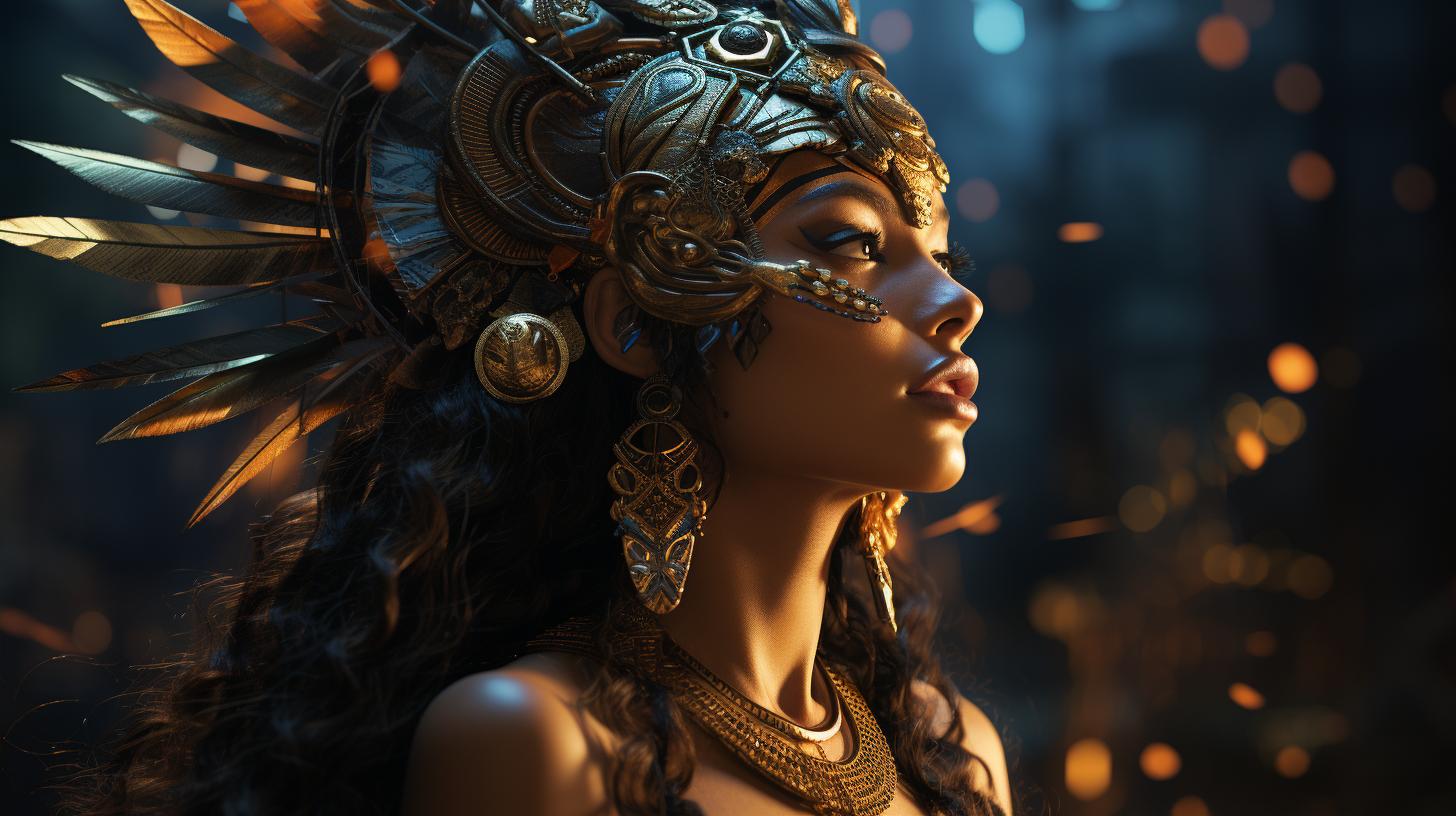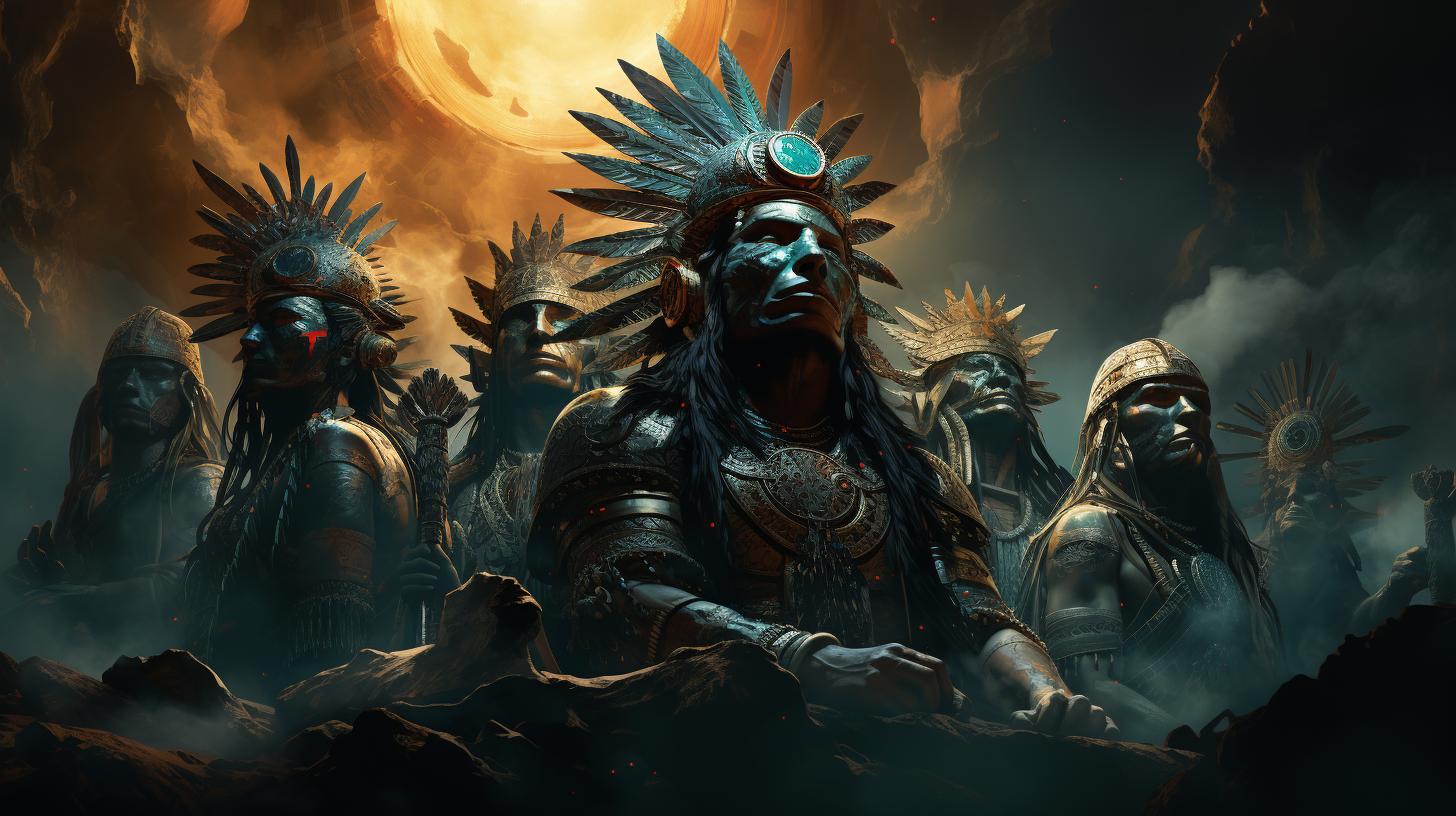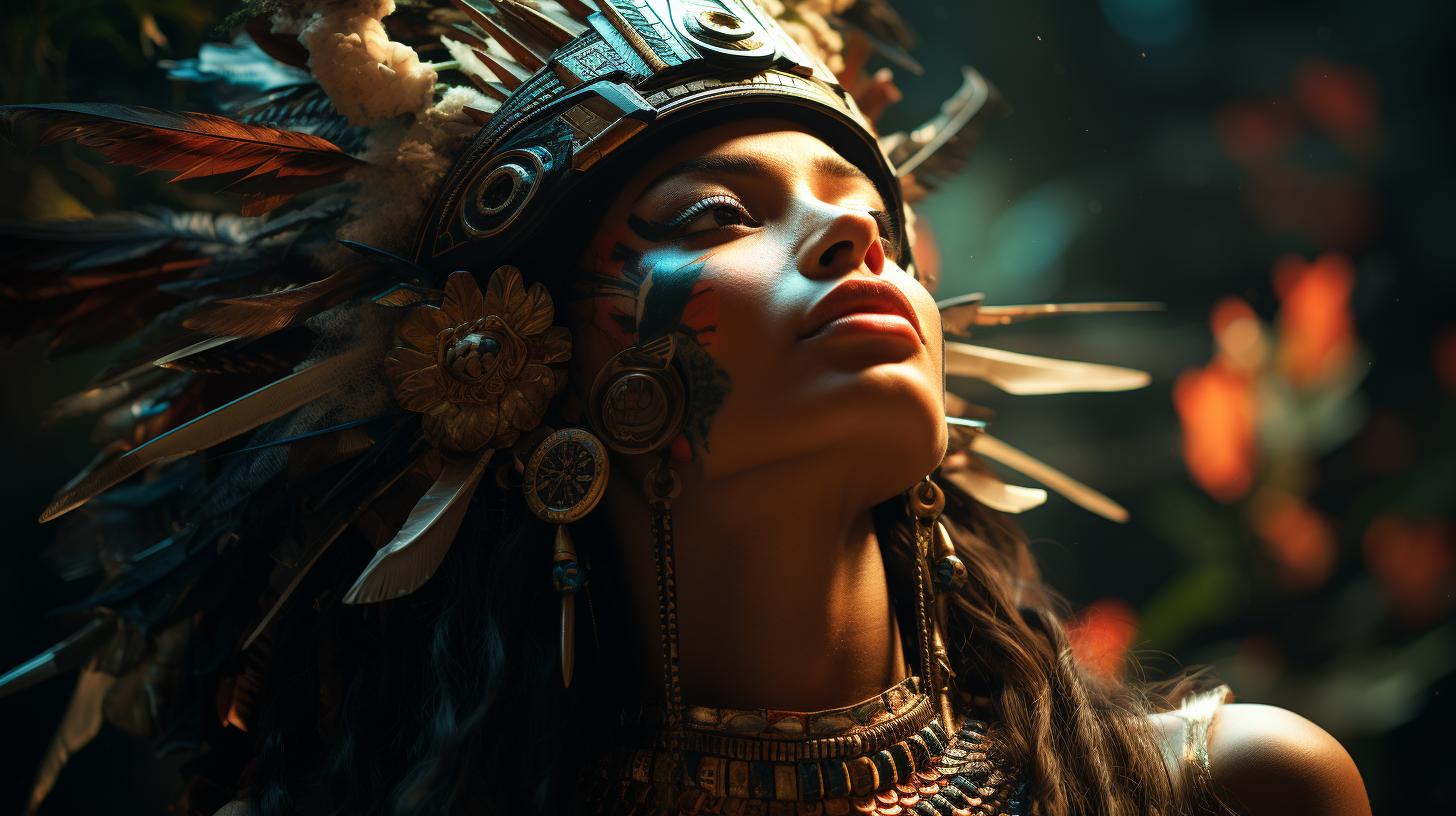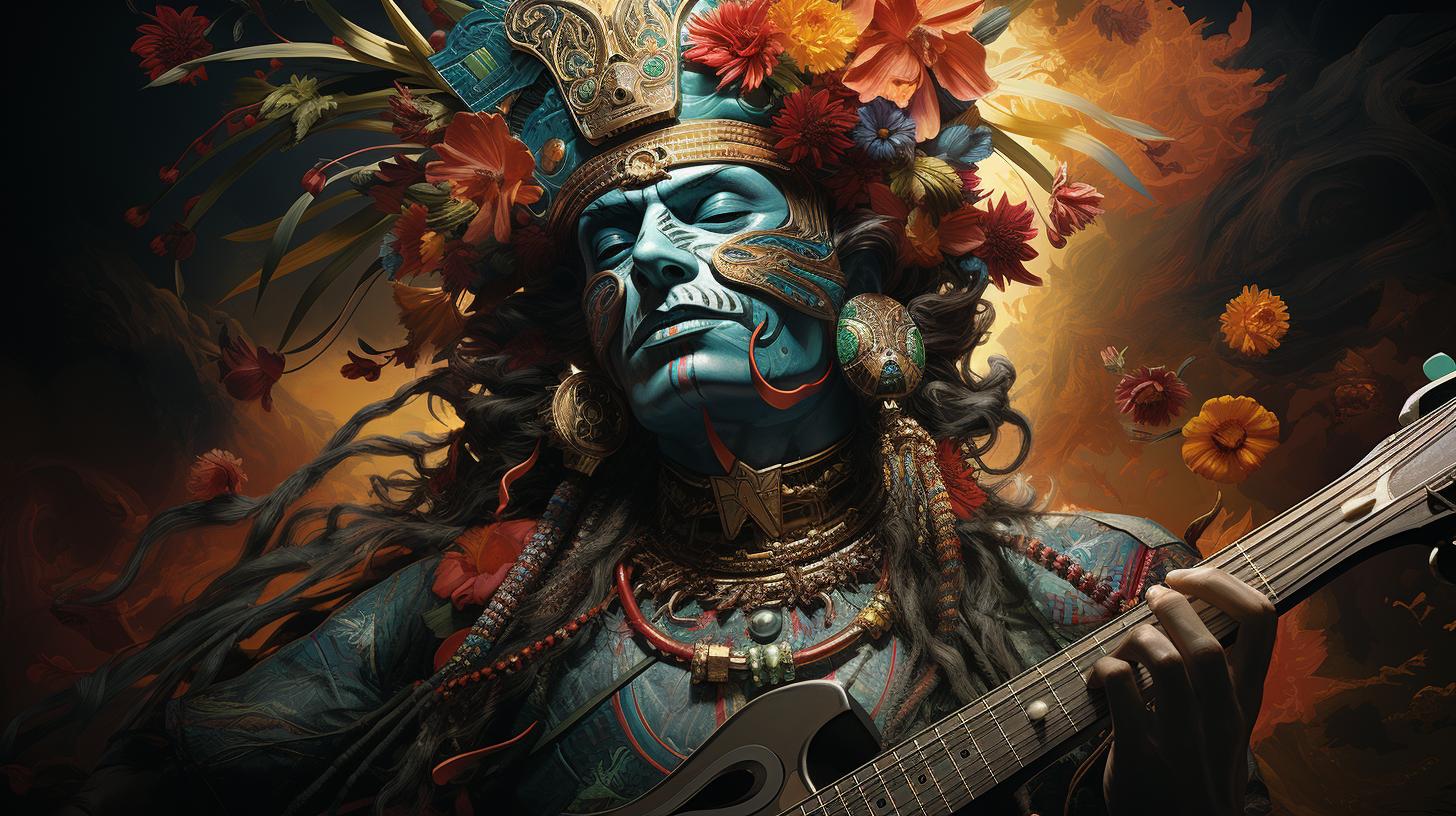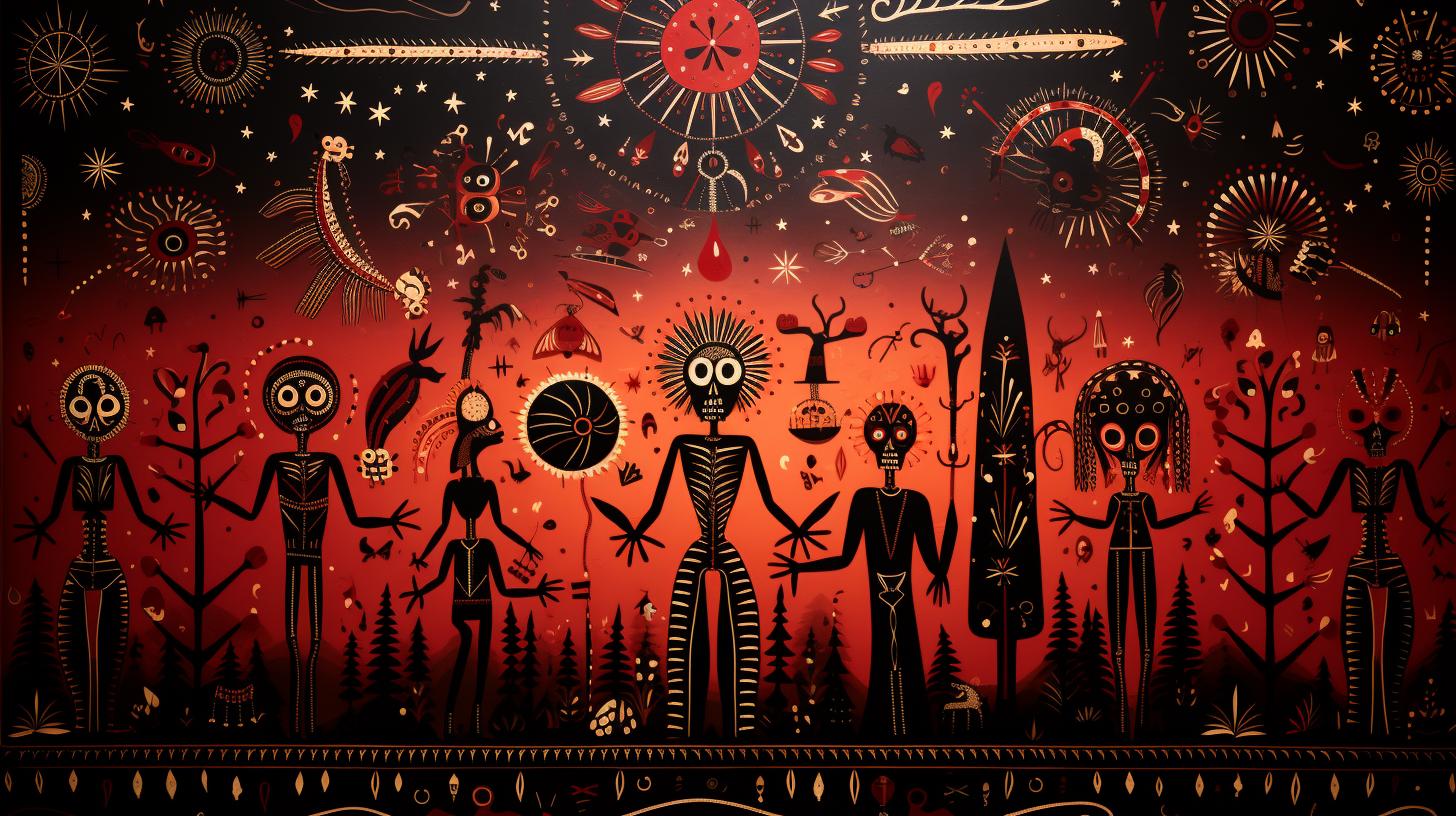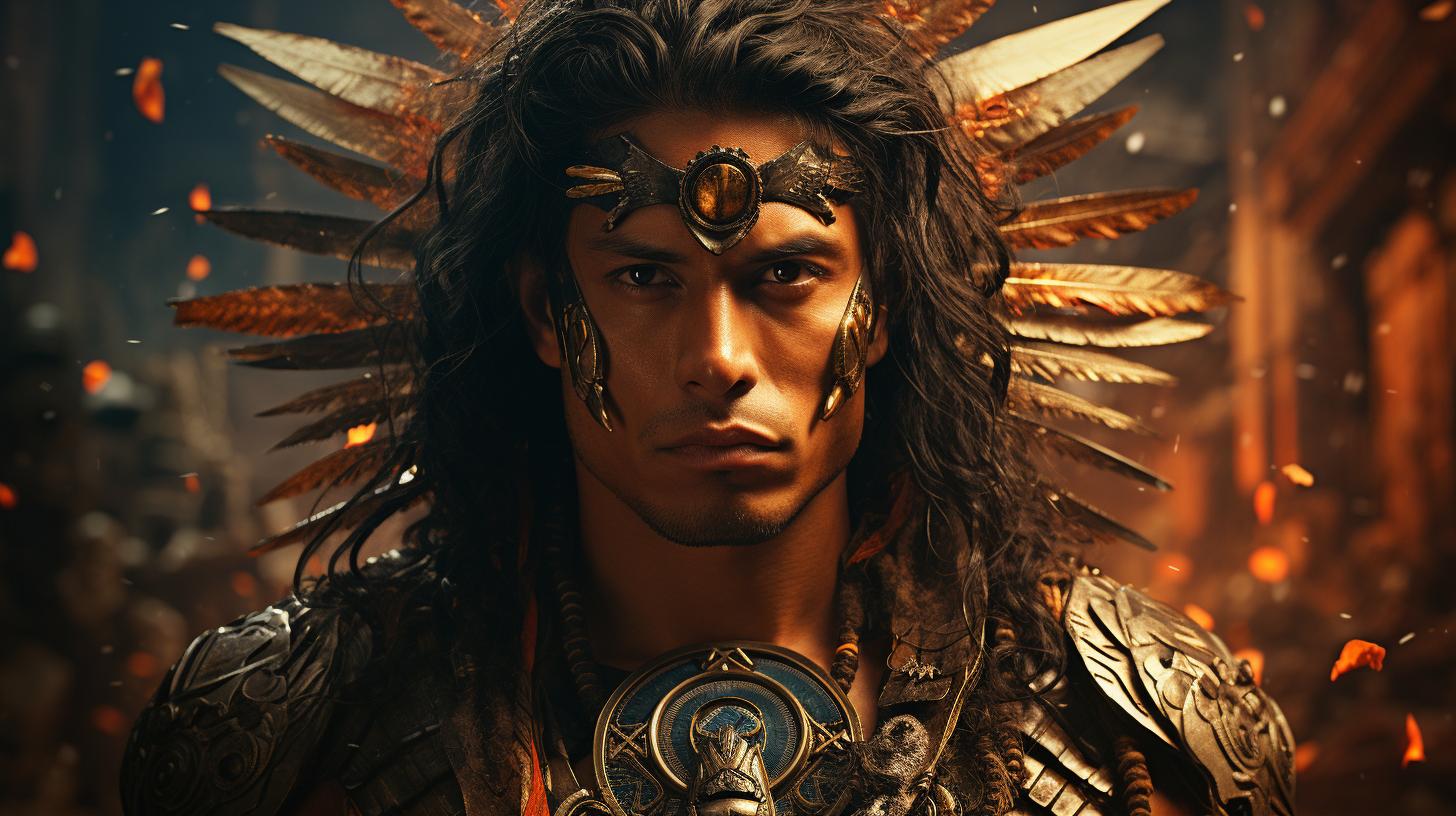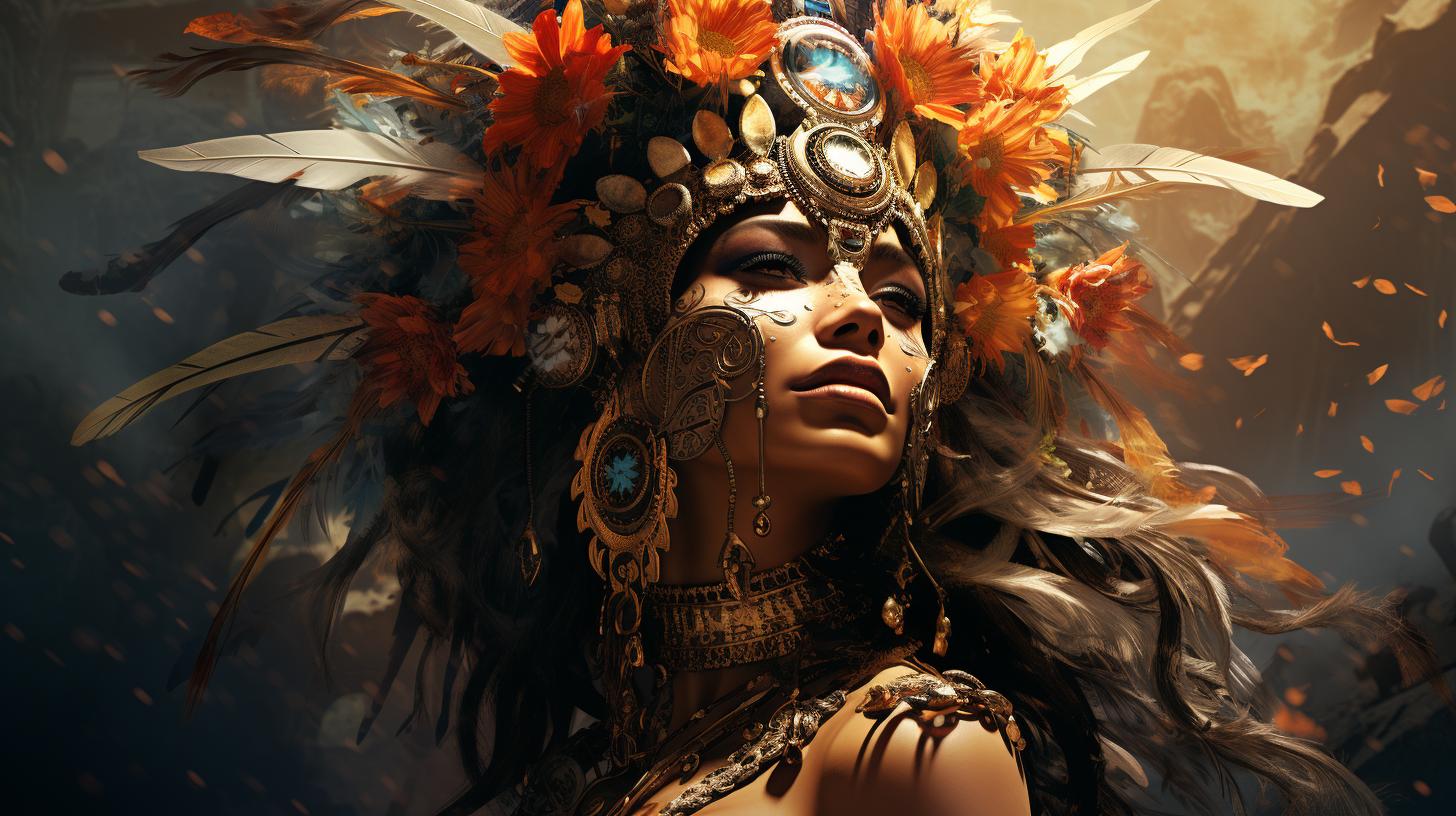Ehecatl Aztec God: The Mighty Deity of Wind and Rain in Aztec Mythology
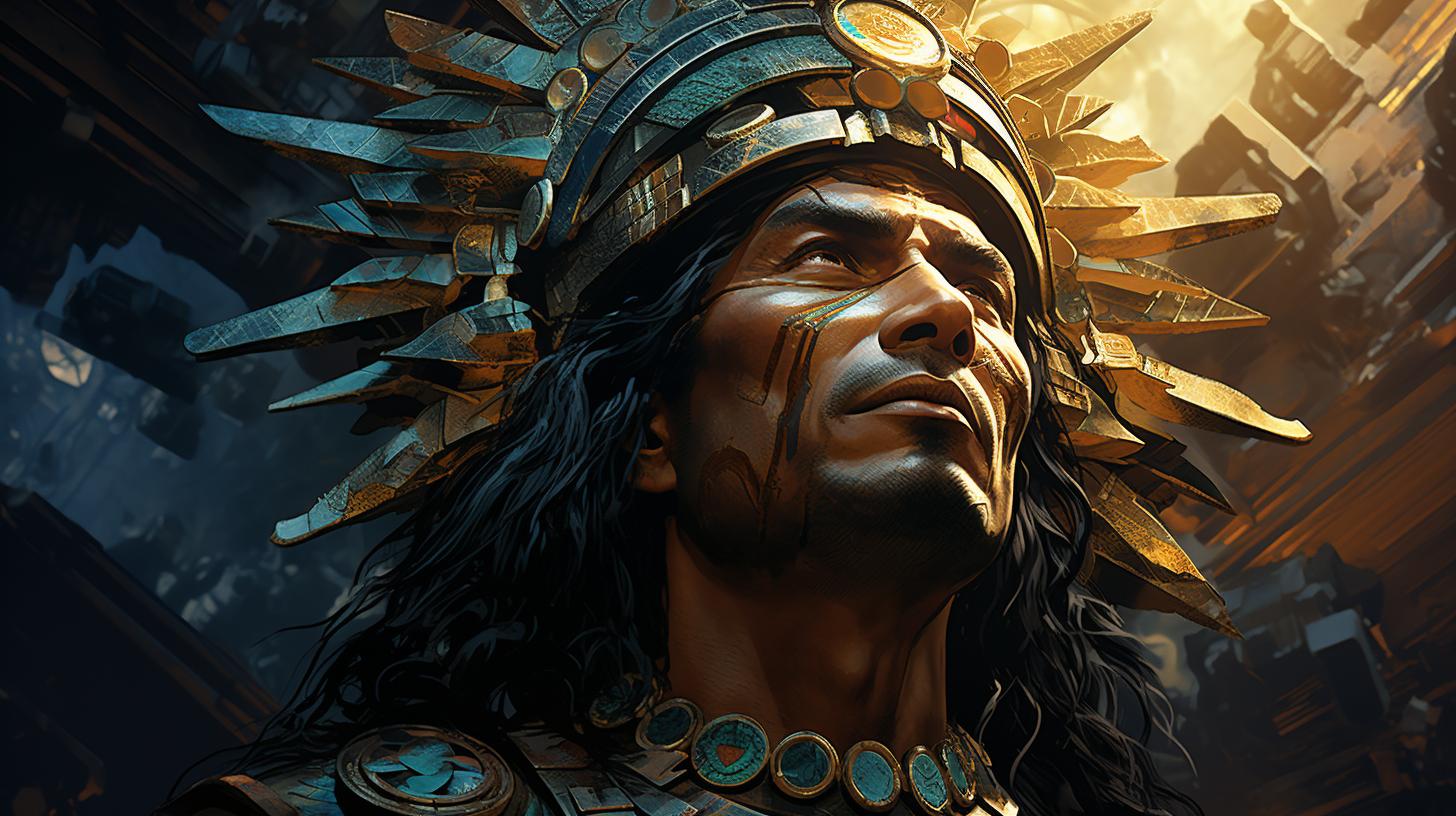
The Aztec god Ehecatl played a significant role in Aztec mythology as a deity of wind and the rains it brought. Associated with Quetzalcoatl, another important god in Mesoamerican pantheon, Ehecatl was also linked to cardinal directions, colors, and various dates in the Aztec calendar.
He was considered the patron of traders and had a connection to spider monkeys due to his swiftness. Ehecatl’s influence extended to the creation of the fifth sun, the movement of the sun and moon, and the gift of the maguey plant to humanity.
Art and literature of the Aztecs depict Ehecatl with his distinctive conical hat, duckbill mask, and symbolic conch shells.
The Aztec Pantheon: An Overview
The Aztec civilization had a rich and complex pantheon of gods, each with their own unique attributes and roles. Among these gods, there existed a diverse range of deities, including those associated with life, death, nature, and celestial phenomena.
In this section, we will explore the Aztec pantheon, specifically focusing on two significant aspects: the gods of death and Ehecatl, the god of wind.
Aztec Gods of Death
Death held a prominent place in Aztec beliefs, with various gods and goddesses associated with different aspects of the afterlife. For instance, Mictlantecuhtli and Mictecacihuatl were the rulers of Mictlan, the underworld or land of the dead.
They presided over the souls of the deceased and were venerated through rituals and offerings.
Ehecatl, the Aztec Wind God
Ehecatl, also known as the god of wind, played a significant role in the Aztec pantheon. He was believed to be one of the manifestations of Quetzalcoatl, one of the most important gods in Mesoamerican mythology.
Ehecatl was associated with the winds that brought rain, making him crucial for agricultural prosperity. His name, derived from the Nahuatl language, translates to “wind.”
As a deity, Ehecatl held multiple responsibilities and attributes.
In addition to his association with the wind, he was also linked to the cardinal directions, various colors, and specific dates in the Aztec calendar. Moreover, Ehecatl was considered the patron of traders and had a connection with spider monkeys due to their swiftness.
Ehecatl played a vital role in the creation story of the Aztecs, particularly in the formation of the fifth and final sun. He was responsible for the movement of the sun and the moon in their celestial courses.
Additionally, Ehecatl is credited with gifting humanity the maguey plant, a crucial resource used for its spines and fermented juice to produce pulque, a traditional alcoholic beverage.
Temples dedicated to Ehecatl had a distinct architectural design, often resembling circular or curved pyramids with conical roofs. This unique shape was believed to represent a tornado or whirlwind, reflecting the awe-inspiring nature of the wind.
Notably, a temple dedicated to Ehecatl was discovered in 2016 underneath a demolished supermarket in Mexico City, further highlighting the deity’s significance.
The visual representations of Ehecatl in Aztec art and literature commonly depict him wearing a conical hat and a duckbill mask or beak. He is often depicted with conch shells, symbolizing his ability to blow divine winds and bring about changes in the weather.
In Conclusion
In conclusion, the Aztec pantheon boasted a diverse array of gods, including those associated with death and natural phenomena. Ehecatl, the wind god, held a prominent place within this pantheon as a deity responsible for bringing rain, influencing the cardinal directions, and contributing to the creation myth.
Represented in various art forms and associated with unique architectural structures, Ehecatl remains a captivating figure in Aztec mythology.
Quetzalcoatl and Ehecatl: The Dynamic Duo of Mesoamerican Mythology
Quetzalcoatl, known as the Feathered Serpent God, and Ehecatl, the Aztec Wind God, formed a powerful duo in Mesoamerican mythology. Quetzalcoatl, with his association with wisdom, knowledge, and creation, captivated the Aztec people with his benevolent nature.
He was often depicted as a feathered serpent, representing the duality of earth and sky.
Ehecatl, on the other hand, represented the forceful and ever-changing nature of the wind. As the personification of the breath of life, he brought rain and fertility to the earth.
The Aztecs saw Ehecatl as a vital divine force that was intricately linked to Quetzalcoatl.
Quetzalcoatl: The Feathered Serpent God
Quetzalcoatl commanded immense respect and reverence as one of the most prominent deities in Aztec belief. His symbol, the feathered serpent, embodied the regenerative powers of nature. Quetzalcoatl’s presence in myths and legends showcased his role as a creator, teacher, and the protector of humanity.
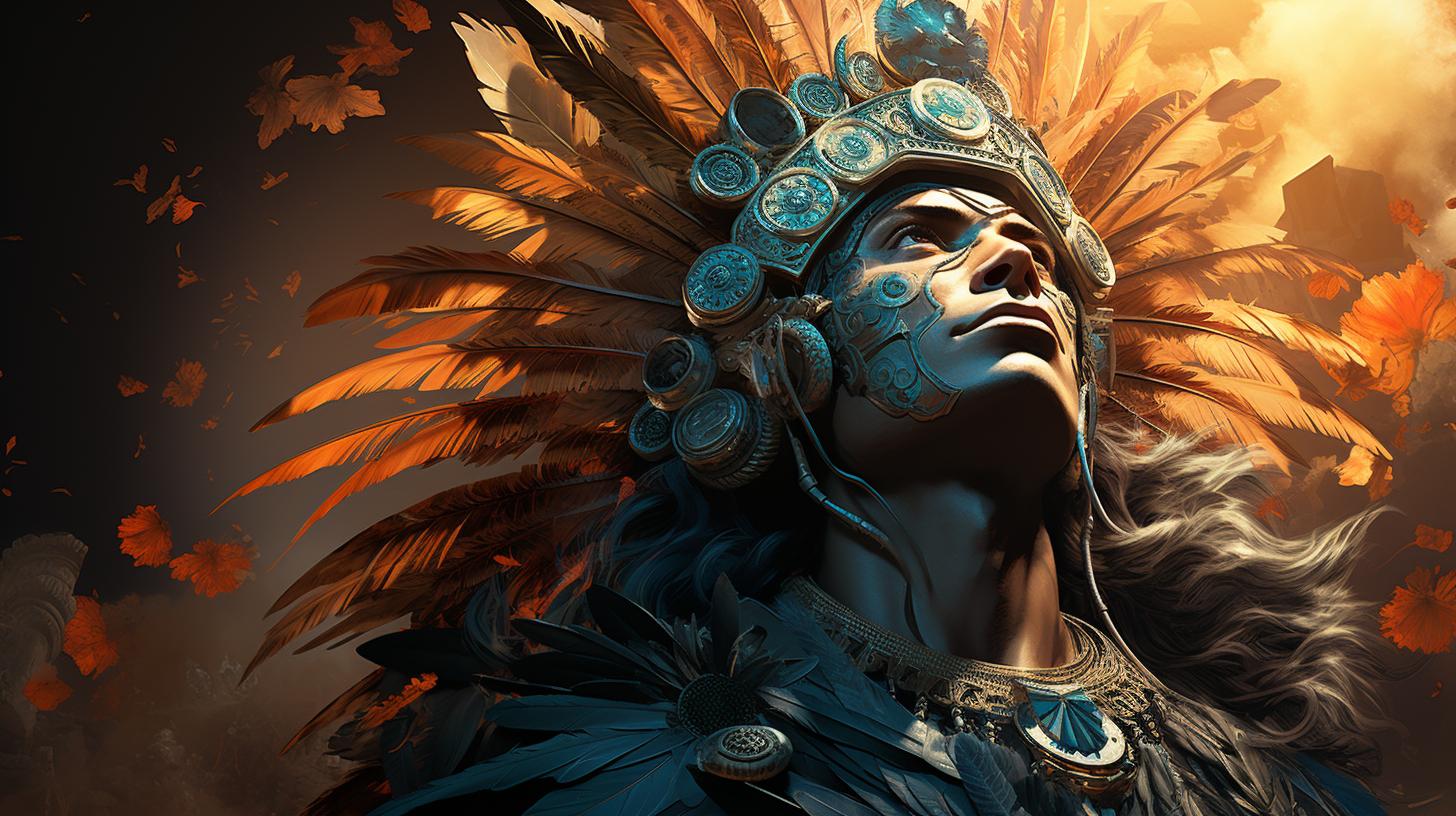
His teachings emphasized harmony, agricultural practices, and the pursuit of knowledge. Quetzalcoatl espoused the ideals of peaceful coexistence and personal enlightenment, promoting a way of life that fostered societal well-being.
Ehecatl and Quetzalcoatl: The Divine Connection
Ehecatl’s association with Quetzalcoatl was profound and pivotal. As manifestations of the same divine essence, these two gods shared a special bond that influenced the spiritual beliefs of the Aztec civilization.
Ehecatl’s role as the wind god complemented Quetzalcoatl’s significance as the feathered serpent god. Their interdependence showcased the intricate relationship between the forces of nature and the cosmic balance they maintained.
This divine connection between Quetzalcoatl and Ehecatl resulted in the belief that the wind was a messenger, carrying Quetzalcoatl’s blessings and guidance to humanity. The Aztecs saw the wind as a tangible manifestation of Quetzalcoatl’s presence, bringing prosperity, rain, and fertility to the land.
Together, Quetzalcoatl and Ehecatl formed a formidable partnership, representing the interplay of order and chaos, wisdom and power, in the intricate tapestry of Aztec mythology.
Ehecatl and the Cardinal Directions: The Wind’s Influence
Ehecatl, the Aztec wind god, held great significance in Aztec culture, particularly in relation to the cardinal directions.
The Aztecs believed that each direction held unique power and symbolism, influencing various aspects of their lives. Ehecatl’s association with the cardinal directions further emphasized his role as a powerful deity with control over the winds.
The Importance of the Cardinal Directions in Aztec Culture
Aztec culture held a deep reverence for the cardinal directions, as they were believed to correspond to different deities, natural elements, and aspects of life. The east, representing the rising sun and new beginnings, was associated with Quetzalcoatl, while the west, signifying the setting sun and death, was linked to Xipe Totec.
The north represented wisdom and abundance, associated with Tezcatlipoca, and the south symbolized fertility and agriculture, associated with Xiuhtecuhtli.
The Aztecs perceived the cardinal directions as interconnected forces, each playing a crucial role in maintaining balance and harmony in the world.
The alignment and arrangement of buildings, temples, and even cities were often based on the cardinal directions, respecting their significance in Aztec cosmology.
Ehecatl’s Association with All Cardinal Directions
Ehecatl’s connection to the cardinal directions further amplified his importance in Aztec mythology. As the god of wind, his influence extended to all four directions. In the east, he was known as Ehecatl-Quetzalcoatl, associated with the refreshing wind that signaled the arrival of a new day.
In the west, he took the form of Ehecatl-Xipe, representing the powerful winds that accompanied the setting sun.
Additionally, Ehecatl was linked to the north and the south, embodying the strong gusts and gentle breezes that played vital roles in the agricultural cycle.
The winds he personified were believed to bring fertility to the land and facilitate successful harvests, ensuring the prosperity of the Aztec people.
The association of Ehecatl with all cardinal directions reinforced his position as a central figure in Aztec cosmology, responsible for maintaining the delicate balance between the natural elements and human existence.
Ehecatl and the Maguey Plant: A Sacred Gift to Humanity
The maguey plant holds a significant place in Aztec mythology, symbolizing both sustenance and spirituality. In the context of Ehecatl, this sacred plant represents a gift bestowed upon humanity. Let us delve into the symbolism and role of the maguey plant as well as Ehecatl’s involvement in introducing it to humanity.
The Symbolism of the Maguey Plant in Aztec Mythology
The maguey plant, known as agave in English, carried deep symbolism for the Aztecs. It was seen as a provider, offering sustenance in the form of food, fiber, and even a fermented beverage called pulque.
Furthermore, the maguey plant was associated with divine elements and was believed to possess spiritual qualities.
According to Aztec mythology, the maguey plant was considered the embodiment of strength and endurance.
Its long leaves and sharp spines were seen as metaphorical representations of the challenges and obstacles faced in life. Additionally, the plant’s ability to thrive in harsh conditions and still yield valuable resources symbolized resilience and adaptability.
Ehecatl’s Role in Introducing the Maguey Plant to Humanity
Ehecatl, as the god of wind and associated with significant natural phenomena, played a crucial role in bringing the maguey plant to humanity. Legends tell that it was Ehecatl who traveled to the realm of the gods and obtained the maguey plant, recognizing its importance for human survival and spirituality.
Ehecatl’s association with the maguey plant involves its cultivation, harvesting, and utilization. This god guided the Aztecs in understanding the plant’s unique properties and taught them how to harvest it properly.
Additionally, Ehecatl was believed to provide divine inspiration to the brewers of pulque, a beverage greatly revered in ancient Aztec culture.
For the Aztecs, the connection between Ehecatl and the maguey plant was not solely practical; it held deeper spiritual significance.
The maguey plant was regarded as a sacred offering from the gods, brought to humanity through the divine influence of Ehecatl.
- Ehecatl ensured the survival and well-being of humanity by introducing the maguey plant into their lives.
- Through the cultivation and use of the maguey plant, the Aztecs honored Ehecatl’s role as a provider and sustainer of life.
- The maguey plant became an essential part of Aztec culture, encompassing both practical and symbolic aspects.
- Ehecatl’s association with the maguey plant highlights his significance as a deity deeply intertwined with human existence and spirituality.
As we explore Ehecatl’s role in introducing the maguey plant to humanity, we discover the intricate interplay between the gods and everyday life in Aztec society.
The Creation Mythology: Ehecatl’s Role in the Aztec Creation Story
The Aztec creation story ponders the origins of the universe and the birth of the gods. Ehecatl, the Aztec wind god, played a crucial role in this captivating narrative. According to Aztec beliefs, Ehecatl contributed to the creation of the fifth and final sun, which brought about life as we know it.
Ehecatl and the Fifth Sun: The Final Creation
In Aztec mythology, each sun represented an era or world. The gods sacrificed themselves to bring forth the new sun and continue the cycle of existence. Ehecatl played a key role in this monumental event, using his power over the winds to propel the sun into its rightful place, illuminating the world and allowing life to flourish.
Ehecatl’s Contributions to the Movement of the Sun and Moon
Ehecatl’s influence didn’t end with the creation of the fifth sun. He also participated in the ongoing movement of the celestial bodies. The Aztecs believed that Ehecatl guided the sun and the moon in their daily journeys across the sky.
With his mastery over the winds, he ensured that these celestial entities followed their designated paths, providing light and maintaining the cyclical nature of time.
Ehecatl’s involvement in the Aztec creation story showcases his immense power and importance within their belief system.
By shaping the universe, playing a role in the birth of the fifth sun, and maintaining the celestial order, Ehecatl embodied the force of wind and its intrinsic connection to the cosmic balance.
Depictions of Ehecatl in Aztec Art and Literature
Sculptures and Codices: Exploring Visual Representations of Ehecatl
Ehecatl, the Aztec god of wind, holds a prominent place in Aztec art and literature. Through sculptures and codices, we gain insight into how this deity was portrayed in the Aztec civilization.
Sculptures of Ehecatl often depict him with a conical hat and a mask resembling the beak of a duck. These sculptures capture the essence of his association with wind and convey his esteemed position in Aztec mythology.
Aztec codices, intricate manuscripts containing historical and mythological narratives, also provide valuable depictions of Ehecatl. These illustrated texts showcase his role in various celestial and natural phenomena, emphasizing his influence over the wind and weather patterns.
The codices serve as visual representations of the rich mythology surrounding Ehecatl and allow us to better comprehend the depth of his significance in Aztec culture.
Ehecatl’s Iconic Symbols: The Conch Shells and Winds of Change
Two iconic symbols commonly associated with Ehecatl are conch shells and the winds of change.
The conch shells represent Ehecatl’s divine ability to blow powerful winds, symbolizing his control over the natural world. They are often depicted alongside the god, signifying his connection with the forces of wind and the transformative power he possesses.
The winds of change, frequently depicted in Aztec art, symbolize the transformative nature of Ehecatl’s influence. These winds, believed to bring forth new beginnings and shifts in destiny, demonstrate Ehecatl’s role as a catalyst for change and renewal.
His association with these winds highlights the dynamic and ever-changing nature of wind itself.
Ehecatl’s depictions in Aztec art and literature are a testament to the significance of his role as the god of wind.
Through sculptures and codices, we gain a visual understanding of his attributes and influence, while the symbols of conch shells and winds serve as iconic representations of his power and association with change.
These depictions provide valuable insights into the depth of Ehecatl’s significance within Aztec culture and mythology.
.











